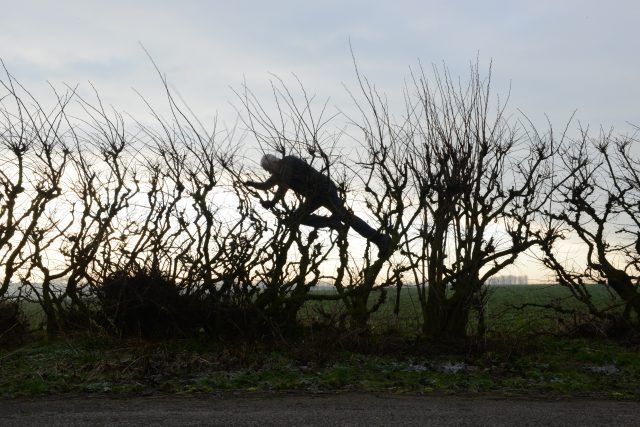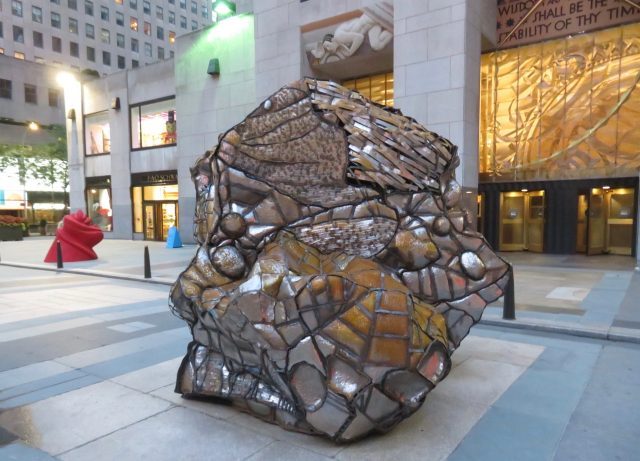
Beatriz Cortez’s Glacial Erratic glitters in front of Lena Henke’s R.M.M. (Power Broker Purple) and R.M.M. (Organ, Organ, Organ Red) (at left) in Rockefeller Center Plaza (photo by twi-ny/mdr)
Who: Ghada Amer, Beatriz Cortez, Andy Goldsworthy, Lena Henke, Camille Henrot, Thaddeus Mosley
What: Site-specific Frieze sculptures
Where: Rockefeller Center Plaza
When: Daily through October 2, free (free Brooklyn Rail artist talk with Andy Goldsworthy September 7 at 1:00)
Why: Last year the Frieze art fair inaugurated “Frieze Sculpture at Rockefeller Center,” a group of site-specific works that complemented the art fair that has been held annually on Randall’s Island since 2012. With this year’s fair canceled because of the pandemic and relegated to online viewing only, the 2020 sophomore edition of “Frieze Sculpture at Rockefeller Center” is a much-needed respite, especially for those who are not yet ready to go inside museums and galleries. The installation is again curated by Isamu Noguchi Foundation and Garden Museum director Brett Littman — Noguchi’s Art Deco piece News has welcomed visitors to 50 Rockefeller Center Plaza since 1938 — and focuses on natural materials in honor of the fiftieth anniversary of Earth Day. In fact, the show was originally scheduled to open on Earth Day, April 22, but had to be rescheduled and reorganized because of the pandemic. “The projects for this year’s Frieze Sculpture deal with a range of issues including women’s suffrage, migration, urban planning, and ecology,” Littman said in a statement. “They are also grounded in the celebration of the natural and botanical worlds, and in some cases the artists use plants and flowers as part of their sculptures. Given our world’s current urgent concerns with ecological sustainability, climate change, and racial inequality — and the impact these issues have had in spreading Covid-19 — the idea of creating an outdoor sculpture installation within this discourse could not be more relevant.”
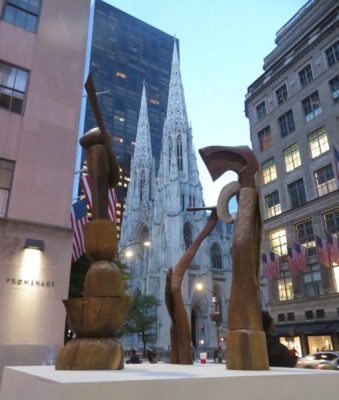
Thaddeus Mosley’s bronze trio melds with the spires of St. Patrick’s Cathedral (photo by twi-ny/mdr)
Greeting everyone at the Fifth Ave. entrance across from Sacks is ninety-four-year-old Pittsburgh-based self-taught artist Thaddeus Mosley’s freestanding bronze trio, Illusory Progression, True to Myth, and Rhizogenic Rhythms, three abstract totems inspired by the salvaged-timber pieces he’s created for decades; they look particularly striking when seen from behind the southwest corner, melding in with the towers of St. Pat’s in the distance. On either side of Channel Gardens is Egypt-born, New York-based artist Ghada Amer’s Women’s Qualities, plantings in the flower beds that form words describing women in a positive way while taking power over gender stereotypes that set impossible ideals, including such traits as Happy, Good Cook, Sexy, Strong, and Smart. In the middle of Channel Gardens is French artist Camille Henrot’s Inside Job, a sea-green bronze sculpture that recalls a breeching dolphin above two shark fins; the piece fits right in with the long, rectangular pools designed by Rene Paul Chambellan that contain fountainhead sculptures of Tritons, Nereids, and other mythic water creatures.
Last month, Rockefeller Center was home to “The Flag Project,” in which the 193 flags of the UN member nations were replaced by flags by established and emerging artists celebrating the resilience of New York City in the face of the current health crisis; for Frieze, Cheshire-born, Scotland-based environmental artist Andy Goldsworthy has installed Red Flags, 109 flags colored in earth samples taken from all fifty states. On September 7 at 1:00, in conjunction with his Frieze piece, Goldsworthy will take part in the Brooklyn Rail’s livestreamed discussion “The New Social Environment #124: Andy Goldsworthy with Jason Rosenfeld,” which will conclude with a poetry reading by Charles Theonia. “Red Flags may not have been conceived as a response to recent events, but it is now bound up with the pandemic, lockdown, division, and unrest,” Goldsworthy said in a statement. “However, I hope that the flags will be received in the same spirit with which all the red earths were collected — as a gesture of solidarity and support. At best, Red Flags will rise above individual states and become a single flowing work of canvas, earth, light, color, stillness, movement, and people.”
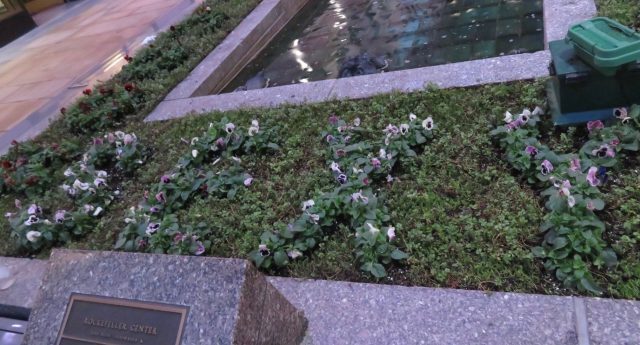
Sexy is just one of the words spelled out in the Channel Gardens flower beds in Ghada Amer’s Women’s Qualities (photo by twi-ny/mdr)
In the center of Rockefeller Plaza is El Salvador-born, LA-based artist Beatriz Cortez’s beguiling Glacial Erratic, a glittering, boulderlike construction made of steel frames and sheet metal that will age over the course of the exhibition, via weather and foot traffic, evoking ancient migration and the many forms of rock found across New York; the title refers to the geological term for rocks that have been transported by glacial ice until they find a home in a glacial valley. Next to that are German-born, New York-based artist Lena Henke’s playful, toylike R.M.M. (Power Broker Purple) and R.M.M. (Organ, Organ, Organ Red), a pair of distorted monster-face sculptures, one purple, one red, that are the same height as Henke and refer to Le Corbusier’s Modulor theory, his investigation into architecture, measurement, and the human body, as well as to Robert Moses’s controversial urban planning designs and several of the bas reliefs around Rockefeller Center. For a slideshow of all the Frieze works, go here.
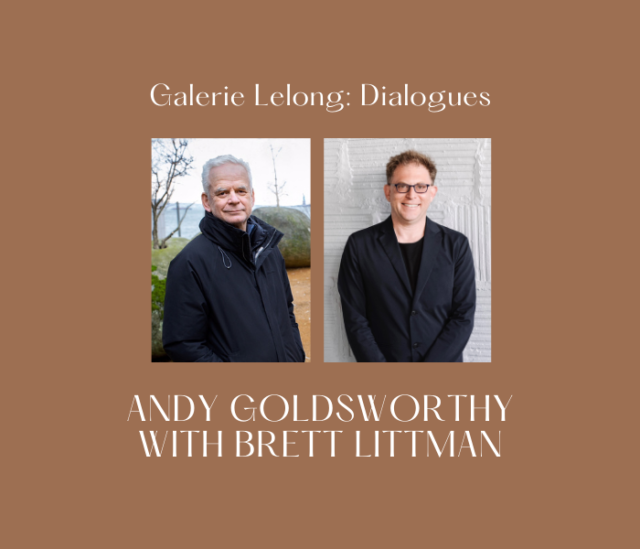
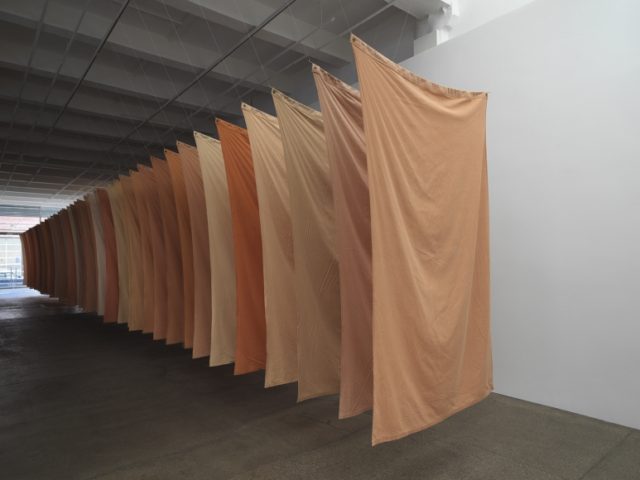
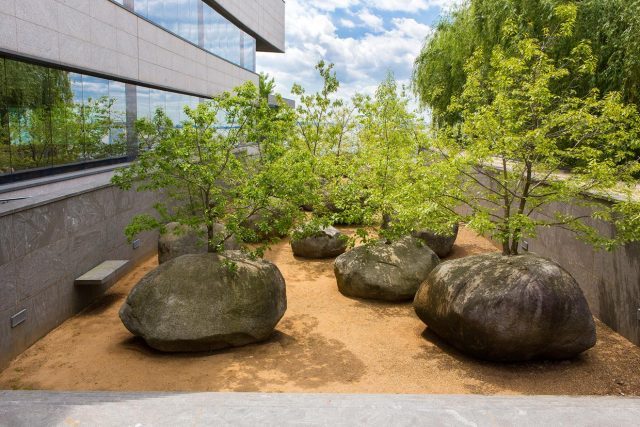



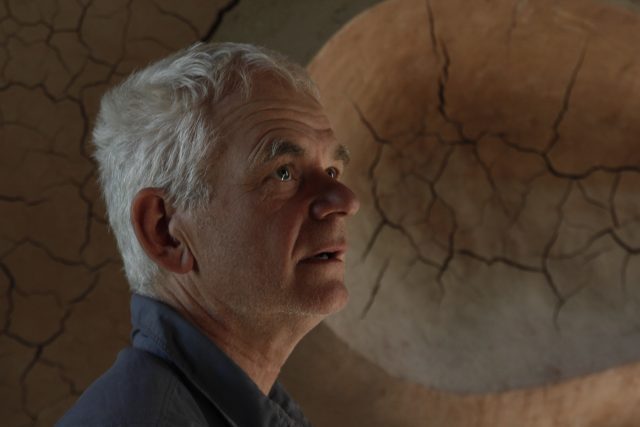
 Thomas Riedelsheimer follows up Rivers and Tides, his 2001 documentary about British artist Andy Goldsworthy, with Leaning into the Wind — Andy Goldsworthy, another fascinating journey with the peripatetic sculptor who uses the world as his canvas, Earth’s natural treasures as his materials. Goldsworthy finds simple pleasures in a beam of light in a cave, a tree fresh with ripe avocados, and walking barefoot on a homemade clay floor. Just as rain starts, he lies down on the street and lets the water pour over him; after a moment, he gets up, leaving a fading, dry outline of his body behind. He plucks leaves and lines them up an outdoor staircase until they form a lovely colored strip that passersby observe as if telling them which way to go. He carves out human shapes in stone to form chambers people can lie in. He has an “intense relationship” with the color yellow. He operates a jackhammer in a quarry. He works with flower petals, mud, twigs, fallen trees, huge rocks — basically, whatever he encounters on his travels can become part of his oeuvre. “I’m still just trying to make sense of the world,” he says. He is like a kid in a candy store as he takes a difficult path among a row of not-too-sturdy bushes or marvels at ants making their way across a forest passage, climbs trees in order to cast a shadow on the grass, and trudges through a stream to get to a favorite log. Many of his spur-of-the-moment works are temporary, to be seen only by himself and his assistant, his daughter Holly, unless captured on film, although plenty of art institutions do hold his work: His
Thomas Riedelsheimer follows up Rivers and Tides, his 2001 documentary about British artist Andy Goldsworthy, with Leaning into the Wind — Andy Goldsworthy, another fascinating journey with the peripatetic sculptor who uses the world as his canvas, Earth’s natural treasures as his materials. Goldsworthy finds simple pleasures in a beam of light in a cave, a tree fresh with ripe avocados, and walking barefoot on a homemade clay floor. Just as rain starts, he lies down on the street and lets the water pour over him; after a moment, he gets up, leaving a fading, dry outline of his body behind. He plucks leaves and lines them up an outdoor staircase until they form a lovely colored strip that passersby observe as if telling them which way to go. He carves out human shapes in stone to form chambers people can lie in. He has an “intense relationship” with the color yellow. He operates a jackhammer in a quarry. He works with flower petals, mud, twigs, fallen trees, huge rocks — basically, whatever he encounters on his travels can become part of his oeuvre. “I’m still just trying to make sense of the world,” he says. He is like a kid in a candy store as he takes a difficult path among a row of not-too-sturdy bushes or marvels at ants making their way across a forest passage, climbs trees in order to cast a shadow on the grass, and trudges through a stream to get to a favorite log. Many of his spur-of-the-moment works are temporary, to be seen only by himself and his assistant, his daughter Holly, unless captured on film, although plenty of art institutions do hold his work: His 